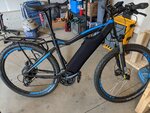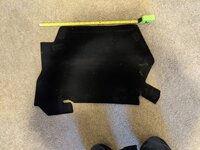Hello!
Well I can't get a ton of info about a neoprene cover to put over the battery for the winter, so I'm designing one myself. I spent a bunch of time trying to figure out the dimensions and made a prototype the other day, cutting out an old sheet which actually fit pretty well. The only issue I'm stuck on is what to do about the controller at the bottom. Does that go inside the case, outside the case, or do I just put it half inside the case, half out.
Inside the case: The part of the controller closest to the bottom bracket/cranks will never be entirely covered. It's just too tight. I like the idea that the controller is inside the case because it will provide a little more heat, although it never seems to get too warm, so I don't think I need to be concerned with overheating. One thing I am concerned with is condensation in case since the controller itself is not perfectly air tight, but with the bike being stored in the garage, that is probably a concern with or without the case and I think all the components inside the controller are sealed up pretty well, supposedly.
Outside the case: The big issue here is that means a significant part (a few inches down the tube) of the battery would not be covered by the case, so I'm leaning against this option right now.
Part in and part out: Basically I get the entire battery in the case, sealed up pretty good at the highest point of the battery. The lowest part of the battery would be exposed just because it's too tight down there to really wrap the neoprene around it. Basically just the right/lower small side would be left uncovered. This is kind of the way I'm leaning. The sheet cutout prototype thing I mentioned is of this right now... well mostly.
Any thoughts on these approaches? It's getting cold and I don't want to lose range where I don't have to!
Well I can't get a ton of info about a neoprene cover to put over the battery for the winter, so I'm designing one myself. I spent a bunch of time trying to figure out the dimensions and made a prototype the other day, cutting out an old sheet which actually fit pretty well. The only issue I'm stuck on is what to do about the controller at the bottom. Does that go inside the case, outside the case, or do I just put it half inside the case, half out.
Inside the case: The part of the controller closest to the bottom bracket/cranks will never be entirely covered. It's just too tight. I like the idea that the controller is inside the case because it will provide a little more heat, although it never seems to get too warm, so I don't think I need to be concerned with overheating. One thing I am concerned with is condensation in case since the controller itself is not perfectly air tight, but with the bike being stored in the garage, that is probably a concern with or without the case and I think all the components inside the controller are sealed up pretty well, supposedly.
Outside the case: The big issue here is that means a significant part (a few inches down the tube) of the battery would not be covered by the case, so I'm leaning against this option right now.
Part in and part out: Basically I get the entire battery in the case, sealed up pretty good at the highest point of the battery. The lowest part of the battery would be exposed just because it's too tight down there to really wrap the neoprene around it. Basically just the right/lower small side would be left uncovered. This is kind of the way I'm leaning. The sheet cutout prototype thing I mentioned is of this right now... well mostly.
Any thoughts on these approaches? It's getting cold and I don't want to lose range where I don't have to!




